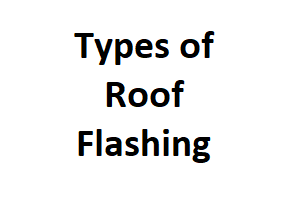Your roof is one of the most important components of your home, safeguarding you and your belongings from the elements. However, even a well-built roof can be vulnerable to water damage if not properly protected. This is where roof flashing comes into play. Roof flashing is a critical element in preventing water infiltration and maintaining the integrity of your roof. In this blog post, we will explore the various types of roof flashing and their importance in safeguarding your home.
1. What is Roof Flashing?
Before we dive into the different types of roof flashing, let’s understand what it is. Roof flashing is a thin, impervious material installed at vulnerable points on your roof to prevent water from seeping into the structure. It acts as a barrier, redirecting water away from potential weak spots such as valleys, vents, chimneys, skylights, and dormers.
2. Drip Edge Flashing
Drip edge flashing is typically installed at the edges of the roof, where the roof deck overhangs the edge of the building. This type of flashing directs rainwater away from the fascia and into the gutters, preventing water from dripping behind the gutters or down the fascia boards. It also helps protect the roof deck from water damage caused by wind-driven rain.
3. Step Flashing
In roofing systems, step flashing finds common use when a vertical surface intersects with a sloping roof plane, such as around chimneys and dormers. This type of flashing creates a stepped pattern, allowing each piece to overlap the other and directing water down and away from vulnerable areas. Step flashing ensures that water does not penetrate the joints between roofing materials and vertical surfaces.
4. Valley Flashing
Valley flashing is employed in the valleys of roofs, where two sloping roof planes meet. Valleys are especially prone to water accumulation, making valley flashing crucial for preventing leaks in these areas. The flashing is installed in a “V” shape, with each side covering the adjacent roof slope, effectively channeling water down the center and away from the valley.
5. Vent Pipe Flashing
Vent pipe flashing is used around vent pipes and other protrusions through the roof, such as plumbing vents and exhaust fans. It forms a watertight seal around the penetration, protecting the roof from potential leaks. Vent pipe flashing often comes in the form of a boot or collar that fits snugly around the pipe, with a flange that overlaps the surrounding roofing material.
6. Chimney Flashing
Chimneys are notorious water entry points for roofs. To prevent water infiltration at the intersection of the chimney and the roof, chimney flashing is utilized. This type of flashing is often a combination of step flashing on the sides and base flashing along the bottom of the chimney. Properly installed chimney flashing ensures that rainwater is diverted away from this vulnerable area.
7. Skylight Flashing
Skylights bring natural light into home, but they can also be a potential source of leaks if not correctly flashed. Skylight flashing ensures that it properly diverts water away from the skylight opening and down the roof slope by combining step flashing, base flashing, and head flashing.
Conclusion
Roof flashing is an essential aspect of a well-protected roofing system. By understanding the different types of roof flashing and their respective applications. You can ensure that your roof remains sturdy and leak-free for years to come. If you’re considering roof repairs or installation, make sure to work with experienced roofing professionals who prioritize proper flashing techniques. With the right roofing materials and meticulous installation, you can safeguard your home from water damage and enjoy peace of mind during rainy seasons and storms.
